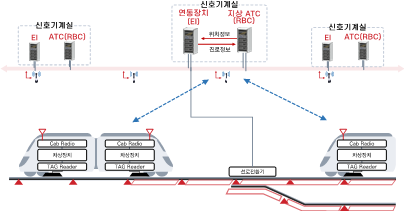|
"KTCS", the foundation of future railway technology 관리자 2024.03.22 |
|
|
"KTCS", the foundation of future railway technology
[Engineering Journal Reporter Jeon Su-jin] Future railway technology is expected to develop the technology necessary to flexibly respond to changes in the railway operation environment. In particular, unmanned operation, currently applied to urban railways and light rail, will also be applied to regular railways and high-speed railways, and research and development in this regard is in progress.
Railroads are characterized by transporting passengers on a large scale and guaranteeing punctuality, but there are limitations in maximizing the efficiency of railroad operation due to the uniform operation method applied, and it is evaluated as a means of transportation with low mobility (service level) of railroad users. I'm receiving it.
Accordingly, in the railway industry, the proportion of wired and wireless communication technology and software technology that can increase efficiency and advance services while considering safety is increasing.
In particular, in Korea, efforts have been made to develop technology that seeks to localize and upgrade the train control system, which is one of the essential technologies for safe unmanned and autonomous train operation.
The train control system is a very important system that detects the positions of city railway and high-speed railway trains moving on the tracks, controls the safety gap between trains, emergency stops approaching trains when there is an abnormality in the tracks or trains, and manages train operation times. It is a facility.
Thales' system has been applied to the Shinbundang Line and Incheon Line 2 Gimhae-Busan Light Rail, which are currently operating unmanned, while the ETCS (Europeon Train Control System) from BT, Thales, and Hitachi has been introduced to general lines such as the Gyeongbu Line and Honam Line, and to the high-speed rail by Hitachi. (formerly Ansaldo)'s ATC (Automatic Train Control) system is in operation.
Although it is a facility that ensures the safe movement of trains and supports efficient operation, it has been very difficult to receive after-sales service (AS) such as repairs because large royalties have been paid in Korea and foreign systems have been introduced and used.
Accordingly, the Korea Railroad Research Institute's Train Control and Communication Laboratory began developing a train control system (KRTCS, currently KTCS) that supports railroad-specific wireless communication network (LTE-R) and WiFi-based unmanned operation in 2010, and developed a Korean-style train control system in 2014. Successfully localized KTCS.
To secure the objectivity of the KTCS development process and the safety of the development system, the researcher applied a safety certification system and performance verification using commercial operation trains, and even secured interoperability between ground signaling equipment and on-board signaling devices to ensure safety and safety. I caught two birds with one stone of trust.
Safety certification for KTCS control devices and software applied the international standard IEC 62278 (Railway applications-Specification and demonstration of reliability, availability, maintainability and safety·RAMS), and the three companies participating in KTCS development achieved the highest safety level, SIL4 (SIL4). Obtained Safety Integrity Level 4) certification.
Yoon Yong-gi (pictured), head of the Train Control and Communication Laboratory at the Korea Railroad Research Institute, said, “To further improve the completeness of KTCS, we verified the performance of KTCS by building a test line on the Daebul Line near Mokpo, and the length of the test line is about 12km (Ilro Station ~ Daebul). Station), the test train used the Gyeongui Line electric train and the next-generation electric train,” he explained.
LS Electric (formerly LS Industrial Systems), Hyundai Rotem Consortium, and STraffic Consortium participated in the development of this KTCS, and its key feature is that it secured interoperability between the three consortia. The aim is to ensure that unmanned driving is carried out normally in all combinations, including the combination between LS Electric's ground signaling equipment and Hyundai Rotem's on-board signaling equipment, and the combination between S-Traffic's ground signaling equipment and LS Electric's on-board signaling equipment. KTCS was successfully commercialized by being applied to the Sillim Line, which opened in May 2022, and is scheduled to be installed on the Northeast Light Rail and Busan Yangsan Line.
With the successful commercialization of KTCS, Korea secured a 100% localized railway system and served as an opportunity for further development of the Korean railway industry.
Currently, the Train Control and Communication Laboratory is working on developing autonomous train technology and 5G technology, and the project to develop autonomous train technology is expected to end this year and become the successor to KTCS.
Director Yoon said, “KTCS consists of ground signal equipment and on-board signal equipment, but the autonomous driving system is characterized by minimizing ground signal equipment installed on the ground and placing most functions as on-board signal equipment.” He added, “The preceding train and the following train “The safety gap control between trains is directly controlled by the train through direct communication between trains, and the train path control at the branch section must be developed so that the train can directly control the track switch,” he said.
He continued, “Recently, as digital and AI technologies are reflected in railroads, digital transformation of railroads is becoming a major keyword. Accordingly, the core technologies being developed in the lab include on-board spacing/branching and automatic driving technology, virtual formation technology based on autonomous train driving, and ultra-low delay communication technology,” he said. “Because sharing of data is very important to successfully promote digital transformation. “We will need to establish a management system to generate, store, and share data so that data sharing between the facilities, vehicles, power, signals, and communications that make up the railroad proceeds organically,” he added.
Copyright © Engineering Journal. Reproduction and redistribution prohibited.
Source: Engineering Journal (http://www.engjournal.co.kr) |
